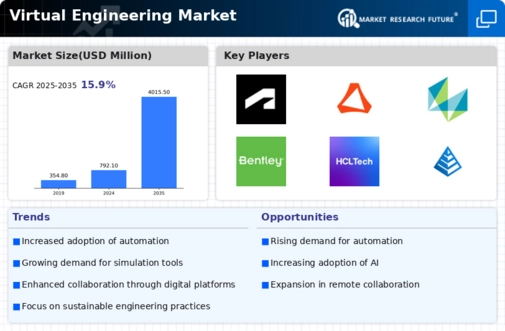Market Trends
Key Emerging Trends in the Virtual Engineering Market
The Virtual Engineering market has been witnessing dynamic trends that are reshaping the landscape of product development and design. As businesses increasingly recognize the value of virtual engineering solutions, the market is experiencing robust growth. One notable trend is the widespread adoption of virtual prototyping and simulation tools. These tools empower engineers to create and test digital prototypes, allowing for rapid iterations and cost savings in the physical prototyping phase. This shift towards virtual prototyping not only accelerates product development cycles but also enhances overall product quality.
More so, virtual reality (VR) and augmented reality (AR) technologies fusion into an innovative trend in the Virtual Engineering market. Augmented and virtual reality provide an immersion into the designed environment, allowing engineers to see how their designs lie on three-dimensional spaces enabling them to have a more integral comprehension of the product. This not only provides for better team working, but it also adds to more educated decisions. In the former, companies are putting their money into VR and AR intermediate courses in order to optimize design reviews, training protocols as well as maintaining practices hence allowing more efficiency across a whole product life.
Besides, increasing user shortages for the digital twin technologies market have led to the emergence of design-centric tendencies. Digital twins refer to the virtual representation of actual goods or systems through which, in real time and continually being updated in situ, monitoring, analytical extraction as well as optimization are made possible. This movement is growing within different fields and includes manufacturing, healthcare industry etc. Digital twins are deployed in various industries and organizations to gained knowledge about product performance, to predict maintenance needs, and optimize operation efficiency. The capability of creating a digital counterpart would model the behavior of physical assets at the real time evolving related to modernize product creation, testing, and progressive tuning.
Another one of the trends driving the change in the direction of Virtual Engineering market is moving towards cloud-based. The ability to scale, the portability of attributes, and collaborative potential are three advantages made possible by cloud computing that become particularly viable for virtual engineering applications. With the changing world of engineering and the accessibility of engineers to work on projects from anywhere, remote collaboration is now a reality as well as efficiency in project performance. Cloud-based solutions help eliminate the overall capital expenses that would be required for extensive hardware investments; thus, virtual engineering tools become more available to a large number of organizations.
In addition, the artificial intelligence and machine learning algorithms are increasingly deployed in virtual engineering technologies. These technologies that improve the predicting ability of the simulations enable engineers to detect problems and plan some countermeasures even before these struggles surface. AI and ML algorithms also auto-systematize some elements of the design process, making product development workflows even smoother. As the Virtual Engineering market continues to evolve, sustainability is becoming a prominent consideration. With a growing emphasis on environmentally conscious practices, virtual engineering enables companies to assess and minimize the environmental impact of their products throughout their lifecycle. This includes evaluating energy consumption, materials usage, and end-of-life considerations in a virtual environment before physical prototypes are produced.














Leave a Comment